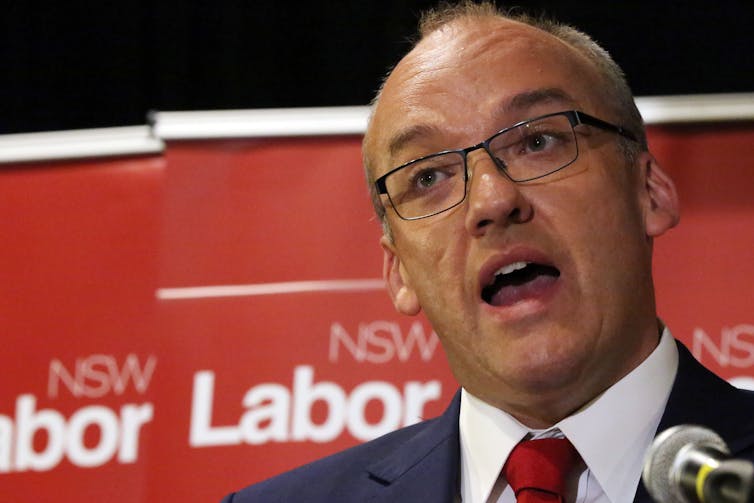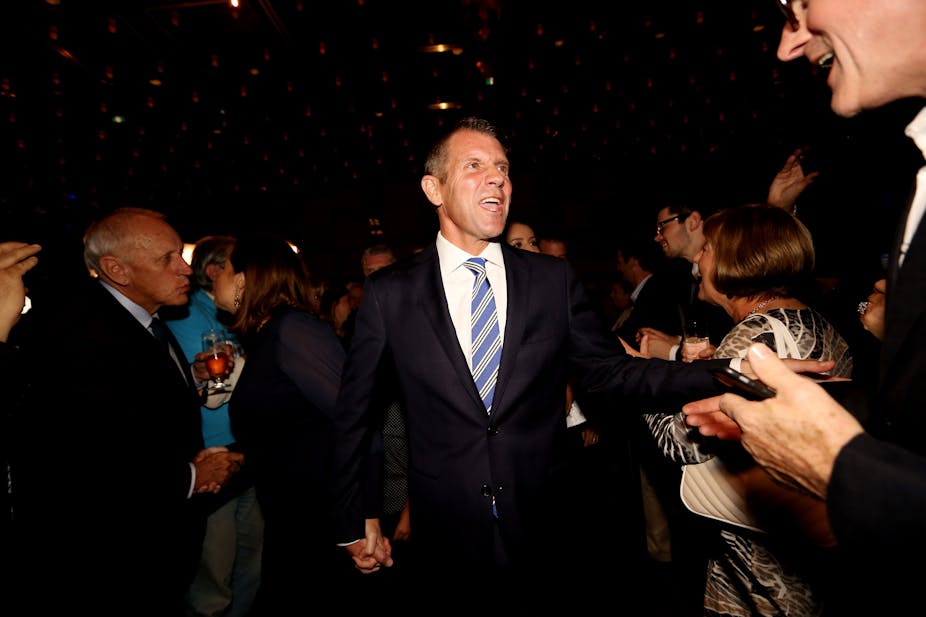With 58% of the lower house vote counted at Saturday’s New South Wales state election, the ABC is currently projecting the Coalition to have won 52 of the 93 lower house seats. Labor is expected to win 32 seats, the Greens four, and the Sydney and Lake Macquarie independents both held their seats. Three seats remain in doubt. The final prediction is Coalition 53, Labor 34.
If the current results are the final outcome, it would represent a 16-seat loss for the Coalition compared with the 2011 election result. Labor would gain 14 seats and the Greens three. Compared with the post-redistribution pendulum, Labor gains 16 seats, the Coalition loses 17 and the Greens gain two.
The current overall primary votes are 45.6% for the Coalition (down 5.5% from 2011), 34.2% for Labor (up 8.6%) and 10.3% for the Greens (steady). As more votes are counted, I expect the Coalition and Greens to both improve their positions slightly at Labor’s expense. It will take at least two weeks before we get a statewide two-party preferred (2PP) vote, but the Poll Bludger thinks the Coalition is currently winning the 2PP by 54.8-45.2, a 9.4% swing to Labor.
While Labor improved greatly on the 2011 wipeout result, this was still a thumping win for the Coalition.
According to the Poll Bludger, minor party preferences split 33% to Labor, 19% to the Coalition and 48% exhausted. Labor thus made up 14 votes per 100 minor party votes, up from 3.5 in 2011. While this gain rate was better for Labor than in either the 2003 or 2007 elections, it is much less than the gain rate at the recent Queensland election.
There were several seats where the swing to Labor was around 20%. However, many of these huge swings were wasted. For example, Myall Lakes, Clarence, Tweed and Upper Hunter were all retained by the Nationals owing to huge pre-election margins. Labor would have won Ballina and Lismore, but finished third in both seats, and its preferences will probably elect Greens.
The projected Greens wins in Ballina and Lismore are not quite certain. The electoral commission’s initial two candidate count in both seats is a Nationals vs Labor count, and it will now have to redo these counts as Nationals vs Greens.
On current primary votes, the Greens need a 9% gain on preferences to defeat the Nationals in Lismore. If many Labor votes exhaust, they could fall short. In Ballina, the Greens need only a 4% gain on preferences, which they should obtain.
For Labor, the most disappointing aspect of the election result is the seats with very low or even negative swings. Labor’s Steve Whan tried to make a comeback in Monaro, after losing by just 2% in 2011, but only won a 0.1% swing. Oatley and East Hills were both retained by the Liberals with swings in their favour.
Labor leader Luke Foley won Auburn – but with a 1.4% swing to the Liberals.
While the Greens overall vote was steady, they easily retained Balmain and Newtown vs Labor, and appear to have won Ballina and Lismore from the Nationals. This was a very good night for the Greens.
We will not be able to judge the polls’ performance accurately until all votes have been counted. The current 11.4% primary vote gap between the major parties is in line with the final polls from ReachTEL and Galaxy, though this gap is likely to increase somewhat as more votes are counted.
Newspoll’s 10-point gap was too low, and the gaps in Ipsos (15 points), Lonergan (16) and Morgan (20) were far too high. Morgan must wish he had not rushed out a final poll, as his second last poll had a 13-point gap, which may be near the final outcome.
Individual seat polls from ReachTEL in Ballina and Newtown, that were taken on the March 19, grossly underestimated the Greens performance. In Newtown, the poll had the Greens losing to Labor by 56.5-43.5, but the Greens currently lead by 61-39. In Ballina, ReachTEL had the Greens 10% behind Labor on primary votes, but the Greens have beaten Labor by 5% for second position.

Coalition strengthens upper house position
The NSW upper house has 42 members, with half elected at each election by proportional representation. There is no group ticket voting system such as is used in the federal Senate. Instead, voters who just vote “1” above the line will have their votes expire within their chosen party.
Voters may give preferences to additional parties by numbering “2”, “3”, etc, above the line. A valid below the line vote requires at least 15 preferences.
The quota for election is 1/22 of the vote or 4.55%. However, because many votes exhaust, seats can be won on about half of that quota, so a little more than 2% can be enough to win a seat.
The 42 current members are 19 Coalition, 14 Labor, five Greens, two Christian Democrats and two Shooters and Fishers. The members elected in 2007 were up for election this year. In 2007, Labor won nine seats of the 21 up at that election, the Coalition eight, Greens two, Christians one and Shooters one.
On current upper house results, the Coalition has 9.5 quotas, Labor 6.9, the Greens 2.2, the Shooters 0.9, the Christians 0.6, and no-one else has more than 0.37 quotas. That means nine seats are filled on quota by the Coalition, six by Labor and two by the Greens, with four others to be filled on less than a quota. It is likely that these four seats will go to Labor, Shooters, Christians and Coalition. I do not think there is much chance of preferences altering this outcome.
Compared with 2007, that means the Coalition will gain two seats to win 10 of the 21 seats up at this election, while Labor loses two to have seven. The Greens, Shooters and Christians will be unchanged at two, one and one seat each respectively.
At the 2011 wipeout election, the result was Coalition 11, Labor five, Greens three, Shooters one and Christians one. Adding the provisional 2015 results gives a total 42-member upper house of Coalition 21 (up two), Labor 12 (down two), Greens five, Shooters two and Christians two. This means the Coalition will only need either the Shooters or Christians to pass legislation, rather than both.
Read more coverage of the 2015 NSW election.

